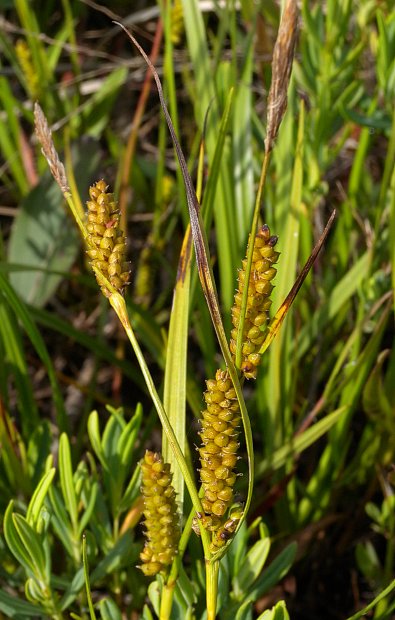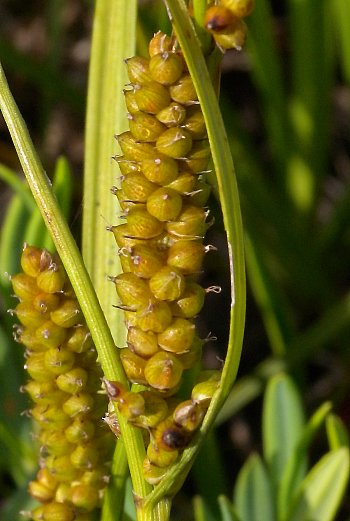
The perigynia (sac-like membranes covering the achenes) are densely packed together on all sides of each pistillate spikelet; these perigynia are oriented horizontally or slightly upward in relation to the central axis of this spikelet. Individual perigynia are about 2.5–3.5 mm. long, 1.5–2.0 mm. across, and glabrous; they are broadly ellipsoid in shape with very short beaks at their tips. Immature perigynia are light green, but they become golden yellow to brown as they mature. The pistillate scales are 1.5–3.0 mm. long and about one-half as much across; they are ovate in shape, tapering to acute tips. These scales are shorter than the perigynia. The terminal staminate spikelet is up to 1¼" (3 cm.) long and very narrow; after blooming, it soon turns brown. The staminate spikelet has an erect peduncle (floral stalk) that is ½–4" long; it is held above the uppermost pistillate spikelet. The blooming period occurs from late spring to mid-summer, lasting about 1-2 weeks for individual plants; the florets are cross-pollinated by the wind. The achenes of this plant are about 1.5–2.0 mm. long and 1.0–1.5 mm. across; they are bluntly 3-angled and obovoid-ellipsoid in shape. The root system is fibrous and long-rhizomatous. Clonal colonies of plants are often formed from the rhizomes.

Cultivation: The preference is full sun, wet to moist conditions, and either very sandy or rocky soil that is calcareous. Temporary flooding is tolerated. This sedge will not tolerate much competition from other plants. Cool to warm summer weather is preferred.
Range & Habitat: The native Crawe's Sedge is found primarily in NE Illinois, where it is rare (see Distribution Map). At one time, Crawe's Sedge was considered 'threatened' in Illinois, however its status has changed with the discovery of additional populations of this plant. It is has a wide distribution in the United States and Canada. In Illinois, habitats of this sedge include wet marly sand, interdunal depressions where moisture accumulates, moist sand flats, margins of beach pools, calcareous seeps, and wet dolomite prairies. Outside of the state, it is sometimes found growing in the cracks of alvars (limestone pavement) near the Great Lakes. It also occurs sparingly in White Cedar fens. This sedge is normally found in high quality natural areas.
Faunal Associations: Crawe's Sedge and other wetland sedges (Carex spp.) are a source of food for such insects as leaf beetles (Plateumaris spp.), billbugs (Sphenophorus spp.), the larvae of leaf-miner flies (Cerodontha spp.), aphids (Allaphis spp., Iziphya spp., Subsaltusaphis spp.), leafhoppers (Cosmotettix spp.), the larvae of skippers (Euphyes spp., Poanes spp.), and sedge grasshoppers (Stethophyma spp.). The seeds and/or seedheads of sedges are eaten by ducks, rails, some species of sandpipers, upland gamebirds, and granivorous songbirds (Martin et al., 1951/1961). Muskrats occasionally feed on their roots and young sprouts.

Photographic Location: Wet marly sand near Lake Michigan in NE Illinois.
Comments: This is a small sedge that is rarely encountered, except in highly specialized habitats. Crawe's Sedge (Carex crawei) resembles the more common Meadow Sedge (Carex granularis) to some extent because of the similar appearance of their pistillate spikelets, and sometimes they can be found growing in the same habitats. Crawe's Sedge differs from the latter sedge by its more narrow leaves (less than 5 mm. across), tendency to form loose colonies of leafy culms rather than dense tufts of leafy culms, and by its production of terminal staminate spikelets on long peduncles (floral stalks), rather than short peduncles or no peduncles. Another distinctive characteristic is the tendency of Crawe's Sedge to produce its lowest pistillate spikelet close to the ground. Both Meadow Sedge and Crawe's Sedge belong to the Granulares Section of sedges (Carex spp.).